| September 04, 2008 |  |
MarsDaily Advertising Kit |
| Previous Issues | Sep 03 | Sep 02 | Sep 01 | Aug 29 | Aug 28 |
Phoenix Mission Conducting Extended Activities On Mars Tucson AZ (SPX) Sep 03, 2008
Tucson AZ (SPX) Sep 03, 2008NASA's Phoenix Mars Lander, having completed its 90-day primary mission, is continuing its science collection activities. Science and engineering teams are looking forward to at least another month of Martian exploration. Due to the spacecraft's sufficient power and experiment capacity, NASA announced on July 31 that the mission would continue operations through Sept. 30. Once the lander ... more Phoenix Analyzing Deepest Soil Sample Yet  Tucson, AZ (JPL) Sep 03, 2008
Tucson, AZ (JPL) Sep 03, 2008Scientists have begun to analyze a sample of soil delivered to NASA's Phoenix Mars Lander's wet chemistry experiment from the deepest trench dug so far in the Martian arctic plains. Phoenix has also been observing movement of clouds overhead. The lander's robotic arm on Sunday sprinkled a small fraction of the estimated 50 cubic centimeters of soil that had been scooped up from the ... more Opportunity Facing New Challenges After Victoria Detour  Pasadena CA (JPL) Sep 03, 2008
Pasadena CA (JPL) Sep 03, 2008Opportunity faces several challenges on the way out of "Victoria Crater" but continues to make steady progress. The first of these is a traverse of approximately 10 meters (30 feet, a little longer than a double-decker bus) across a sandy, 17-degree slope. Opportunity is more than halfway through that part of the journey. The next is a drive across 30 to 50 meters (100 to 160 feet) ... more Giant Telescope Mirror Blank Is Perfect  Tucson AZ (SPX) Sep 03, 2008
Tucson AZ (SPX) Sep 03, 2008The single-piece primary and tertiary mirror blank cast for the LSST is "perfect", say project astronomers and engineers. The LSST, or Large Synoptic Survey Telescope, a large survey telescope being built in northern Chile, requires three large mirrors to give crisp images over a record large field of view. The two largest of these mirrors are concentric and fit neatly onto a single mirror ... more Mars Research In Polar Bear Country  Moffett Field CA (SPX) Sep 02, 2008
Moffett Field CA (SPX) Sep 02, 2008Hans Amundsen is a Norwegian geologist and the expedition leader of AMASE (Arctic Mars Analog Svalbard Expedition). AMASE is an international, interdisciplinary scientific research project that since 2003 has traveled to Svalbard, a group of islands in the High Arctic that provides some of the best sites on Earth for doing Mars-related field research. Among the most valuable geologic ... more |
mars-mers
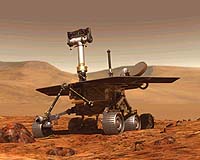 mars-phoenix 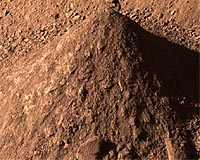 mars-mers 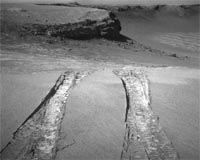 |
 Boston MA (SPX) Sep 01, 2008
Boston MA (SPX) Sep 01, 2008Researchers examining images of gullies on the flanks of craters on Mars say they formed as recently as a few hundred thousand years ago and in sites once occupied by glaciers. The features are eerily reminiscent of gullies formed in Antarctica's mars-like McMurdo Dry Valleys. The parallels between the Martian gullies and those in Antarctica's McMurdo Dry Valleys were made using the latest ... more Phoenix Lander Pictures Show Robotic Arm's Workspace After 90 Sols  Tempe AZ (SPX) Aug 29, 2008
Tempe AZ (SPX) Aug 29, 2008New pictures from NASA's Phoenix Lander show just what a busy summer the spacecraft on Mars - and its science team at The University of Arizona in Tucson - has been having. During the first 90 Martian days, or sols, after its May 25, 2008, landing on an arctic plain of Mars, the lander dug several trenches in the workspace reachable for its robotic arm. The lander's Surface Stereo ... more Fresh From Mars: Scientist To Describe H20 Discovery  Dallas TX (SPX) Aug 28, 2008
Dallas TX (SPX) Aug 28, 2008Water on Mars? Scientists suspected the presence of H2O on the surface of our planetary next-door neighbor, but it took a series of tests and University of Texas at Dallas Professor John Hoffman's instrument aboard NASA's Phoenix Mars Lander to prove it. Hoffman will tell audiences at the Museum of Nature and Science on Aug. 30 how he and his team made one of this century's first major ... more NASA's Mars Rover Opportunity Climbing Out Of Crater  Pasadena CA (SPX) Aug 27, 2008
Pasadena CA (SPX) Aug 27, 2008NASA's Mars Exploration rover Opportunity is heading back out to the Red Planet's surrounding plains nearly a year after descending into a large Martian crater to examine exposed ancient rock layers. "We've done everything we entered Victoria Crater to do and more," said Bruce Banerdt, of NASA's Jet Propulsion Laboratory in Pasadena, Calif. Banerdt is project scientist for Opportunity and ... more |
mars-phoenix
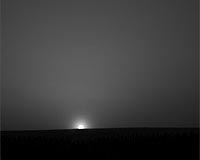 asteroid 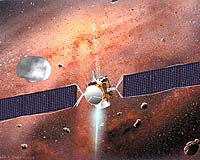 mars-dust 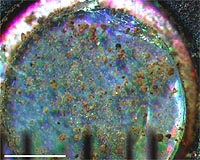 |
 Tucson AZ (SPX) Aug 26, 2008
Tucson AZ (SPX) Aug 26, 2008The next sample of Martian soil being grabbed for analysis is coming from a trench about three times deeper than any other trench NASA's Phoenix Mars Lander has dug. On Tuesday, Aug. 26, the spacecraft will finish the 90 Martian days (or "sols") originally planned as its primary mission and will continue into a mission extension through September, as announced by NASA in July. Phoenix lander ... more Liquid Water in the Martian North  Moffett Field CA (SPX) Aug 25, 2008
Moffett Field CA (SPX) Aug 25, 2008Perchlorate. Never heard of it? Join the club. But NASA's Phoenix spacecraft has found it in the soil in the icy northern plains of Mars. And now that it's been found, scientists are scrambling to explain how it got there, and what, if anything, its presence means about the habitability of the martian north. Phoenix didn't go to Mars to find perchlorate. It went looking for evidence of ... more Meteorite Fast Track  Moffett Field CA (SPX) Aug 25, 2008
Moffett Field CA (SPX) Aug 25, 2008For the last few years, astronomers have faced a puzzle: The vast majority of asteroids that come near the Earth are of a type that matches only a tiny fraction of the meteorites that most frequently hit our planet. Since meteorites are mostly pieces of asteroids, this discrepancy was hard to explain, but a team from MIT and other institutions has now found what it believes is the answer to the ... more Mid-Depth Soil Collected For Lab Test On NASA's Mars Lander  Tucson AZ (SPX) Aug 25, 2008
Tucson AZ (SPX) Aug 25, 2008NASA's Phoenix Mars Lander has scooped up a soil sample from an intermediate depth between the ground surface and a subsurface icy layer. The sample was delivered to a laboratory oven on the spacecraft. The robotic arm on Phoenix collected the sample, dubbed "Burning Coals," from a trench named "Burn Alive 3." The sample consisted of about one-fourth to one-half teaspoon of loose soil ... more
|
microsat
 mars-life 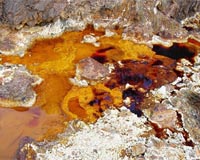 mars-phoenix 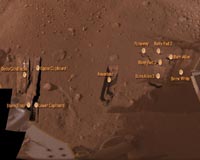 |
| Previous Issues | Sep 03 | Sep 02 | Sep 01 | Aug 29 | Aug 28 |
| The contents herein, unless otherwise known to be public domain, are Copyright 1995-2007 - SpaceDaily. AFP and UPI Wire Stories are copyright Agence France-Presse and United Press International. ESA Portal Reports are copyright European Space Agency. All NASA sourced material is public domain. Additional copyrights may apply in whole or part to other bona fide parties. Advertising does not imply endorsement, agreement or approval of any opinions, statements or information provided by SpaceDaily on any web page published or hosted by SpaceDaily. Privacy statement |